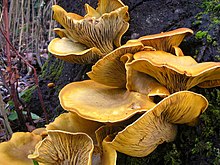| Omphalotus olivascens | |
|---|---|

| |
| Scientific classification | |
| Domain: | Eukaryota |
| Kingdom: | Fungi |
| Division: | Basidiomycota |
| Class: | Agaricomycetes |
| Order: | Agaricales |
| Family: | Omphalotaceae |
| Genus: | Omphalotus |
| Species: | O. olivascens |
| Binomial name | |
| Omphalotus olivascens H.E.Bigelow, O.K.Mill. & Thiers (1976) | |
| Omphalotus olivascens | |
|---|---|
| Gills on hymenium | |
| Cap is infundibuliform | |
| Hymenium is decurrent | |
| Stipe is bare | |
| Spore print is yellow | |
| Ecology is saprotrophic | |
| Edibility is poisonous | |
Omphalotus olivascens, commonly known as the western jack-o'-lantern mushroom, is an orange to brown-colored gilled poisonous mushroom endemic to the California Floristic Province. It is sometimes mistaken for chanterelles.
Taxonomy
The fungus was described as new to science in 1976 by American mycologists Howard E. Bigelow, Orson K. Miller Jr., and Harry D. Thiers. A subspecies with blue flesh, O. olivascens var. indigo, was described growing on live oak in Baja California, Mexico.
Description
To an untrained eye, O. olivascens appears similar to some chanterelles, but unlike the chanterelle, the jack-o'-lantern mushroom has true, blade-like gills (rather than ridges) and it can have olive coloration that chanterelles lack; also, Omphalotus species are saprotrophic, grow directly on wood, and are bioluminescent.
The cap is 4–18 cm (1.6–7.1 in) wide. The stalks are 4–15 cm (1.6–5.9 in) long and 1–4 cm (0.39–1.57 in) wide. The spores are white to pale yellow.
Ecology
A saprobe or parasite, O. olivascens is usually found on oak or Eucalpytus, rarely on other hosts.
Omphalotus species cause a white rot by breaking down lignin in their tree hosts.
Biochemistry
The jack o'lantern mushroom is poisonous; while not lethal, consuming this mushroom leads to very severe cramps, vomiting, and diarrhea.
The toxic ingredient of many species of Omphalotus is a sesquiterpene compound known as illudin S. This, along with illudin M, have been identified in O. nidiformis. The two illudins are common to the genus Omphalotus and not found in any other basidiomycete mushroom.
Similar species
See also: Omphalotus illudensSeveral Omphalotus species with similar bioluminescent properties occur worldwide, all of which are presumed poisonous. The best known are the North American jack o'lantern mushroom (O. olearius) and the tsukiyotake (O. japonicus (Kawam.) Kirchm. & O.K. Mill. (formerly known as Lampteromyces japonicus (Kawam.) Sing.), found in Japan and eastern Asia. Molecular analysis shows the jack-o'-lantern to be most closely related to the ghost fungus Omphalotus nidiformis. Miller notes that the colours and shades of the ghost fungus most closely resemble this species.
Gymnopilus junonius is another similar-looking species.
See also
References
- Thiers, Harry D.; Arora, David (September 1980). "Mushrooms Demystified". Mycologia. 72 (5): 1054. doi:10.2307/3759750. ISSN 0027-5514.
- Bigelow HE, Miller OK Jr, Thiers HD (1976). "A new species of Omphalotus". Mycotaxon. 3 (3): 363–372.
- Moreno G, Esteve-Raventós F, Pöder R, Ayala N (1993). "Omphalotus olivascens var. indigo, var. nov. from Baja California (Mexico)". Mycotaxon. 48: 217–22.
- Meuninck, Jim (2017). Foraging Mushrooms Oregon: Finding, Identifying, and Preparing Edible Wild Mushrooms. Falcon Guides. p. 4. ISBN 978-1-4930-2669-2.
- ^ Michael Wood & Fred Stevens. "Omphalotus olivascens". California Fungi. Retrieved 2011-03-25.
- ^ Davis, R. Michael; Sommer, Robert; Menge, John A. (2012). Field Guide to Mushrooms of Western North America. Berkeley: University of California Press. pp. 143–144. ISBN 978-0-520-95360-4. OCLC 797915861.
- ^ Kirchmair M, Morandell S, Stolz D, Pöder R (2004). "Phylogeny of the genus Omphalotus based on nuclear ribosomal DNA-sequences". Mycologia. 96 (6): 1253–1260. doi:10.2307/3762142. JSTOR 3762142. PMID 21148949.
- Benjamin DR (1995). Mushrooms: Poisons and Panaceas — A Handbook for Naturalists, Mycologists and Physicians. New York, New York: WH Freeman and Company. pp. 366–67. ISBN 0-7167-2600-9.
- Kirchmair, Martin (1999). "Identification of illudins in Omphalotus nidiformis and Omphalotus olivascens var. indigo by column liquid chromatography–atmospheric pressure chemical ionization tandem mass spectrometry". Journal of Chromatography A. 832 (1–2): 247–52. doi:10.1016/s0021-9673(98)00892-9. ISSN 0021-9673. PMID 10070774.
- Miller OK. Jr. (1994). "Observations on the genus Omphalotus in Australia". Mycologia Helvetica. 6 (2): 91–100.
External links
 Media related to Omphalotus olivascens at Wikimedia Commons
Media related to Omphalotus olivascens at Wikimedia Commons- Omphalotus olivascens in Index Fungorum
- Omphalotus olivascens in MycoBank.
| Taxon identifiers | |
|---|---|
| Omphalotus olivascens | |